Modern Maverick could be Ford’s bargain bonanza
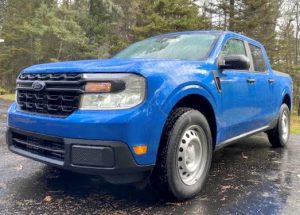
The 2022 Ford Maverick is conveniently downsized from Ranger-size, but retains the look of a larger pickup.
By John Gilbert
It was only a week-long test drive, but the 2022 Ford Maverick proved it could have the power to establish new ground-rules in the hotly competitive world of pickup trucks. Fr0om its performance, and the impact it seemed to have on others, it indicates that style counts a lot, color and pizazz matter too, further proves trucks have indeed become the new cars of the current era…and it might even indicate the love of enormous pickups could be heading for the history books.
Now, all those things can’t possibly happen because of one undersized pickup, can they?
After all, there will always be a need for large pickups for those who need size and power for heavy work detail, so we aren’t ready to render them as dinosaurs. But midsize and compact trucks are gaining in popularity, and the Maverick gives off a a macho, big-trick impression while also handling with agility and car-like city maneuvers, and strong economy and sticker-price benefits.
We hadn’t had a test car for a few weeks, because of chip shortages and pandemic hangover, so we were thankful when the Maverick showed up. As a veteran auto writer, I recall less than fondly Ford’s first Maverick, a compact that seemed to be built of leftover parts from predecessors, most of which were more attractive and more successful. When Ford stopped making the original Maverick, I was relieved, being a lover of neat cars. So the return of the Maverick wasn’t something our household had been eagerly awaiting.
But Ford, gambled that a new generation twice removed won’t remember the downside of the previous Mavericks, and besides, this one is a pickup. Ford is king of pickups, with the large F150 the top seller annually, and the larger F-250 and F-350 hauling hefty things, and now the return of the Ranger downsized pickup is battling compact pickups from Chevy, GMC, Toyota and Nissan. Ford never spott a trend it didn’t see as a challenge, and this one, toward downsizing success, allowed Ford to follow its own current trend. So out comes a downsized downsized pickup called the Maverick — a bit smaller than the Ranger but still with a rugged pickup-y macho look.
The test vehicle was not a loaded Lariat, or a semi-loaded XLT, but an XL, which still has an impressive sound but which counts as Ford’s delineation of the “base” model in our era of marketing hyperbole. That’s fine, I figured, because I enjoy getting the more base models sometimes just to avoid being spoiled by all the gadgetry of the loaded versions. It’s fun, however, to test the options, too; maybe later.
This test Maverick was decidedly unloaded, and the price tag reflected it: Base price $19,995, just so we can announce it as “under $20,000,” and as equipped it rose to only $23,860.
We were going to drive this Maverick as if we were a young family and this was our choice of family car. Three of four times, when I’d park downtown or at the Whole Foods lot, a passerby would catch my eye and walk over with repetitive approaches: “Is this the new…Maverick? We’ve been looking at these online. How do you like it?” That would be followed by several minutes of conversation, and after several, I was impressed at how many people spotted the vehicle and knew it was a Maverick, since it hadn’t reached the public yet, or many showrooms, even.
One Ford salesman I know said his dealership had never had such overwhelming requests for information and for advance orders, and he said they have taken to suggesting buying immediately when a load show up, because the word now is that anyone making an order as October ends will mean delivery sometime in midsummer 2022!
The shape, the styling, the Velocity Blue Metallic paint, all were attractions, and the super-neat shape and size were too. When you park next to a full-sized pickup, you’re amazed how low the Maverick is. A normal adult can look over the top of the roof. Women are choosing pickups more and more, and there seems to be a universale attraction of female buyers seeking Mavericks.
It was the perfect week to have the Maverick, because the UMD hockey team was headed off to Minneapolis to face the arch-enemy University of Minnesota Gophers Friday night, with a return match in Duluth Saturday. We decided to drive down and see how our former Minneapolis home area had changed over the past 10 or 20 years.
Among the options on the Maverick were a 2.0-liter EcoBoost turbocharged engine with 250 horsepower, and 277 foot-pounds of torque, plus a sophisticated 8-speed automatic transmission with autostart and stop-start, and LED headlights with auto-dim and automatic shutoff.
Among the options NOT included at that very low price were: Styled alloy wheels, cruise control, leather (or any facsimile thereof) on the bucket seats, navigation, cruise control, seat heaters, satellite radio, foglights (although there were neat fake foglight covers that made it look like you really had ‘em but you were being careful to protect ‘em). Those, remember, were all among the missing features that higher-trim Mavericks would have or could have. Did I mention cruise control?
Without cruise on the freeway, the Maverick was more truck-like, eager to wander and less than precise in its steering trajectory. Maybe a Sport mode button could have helped that feeling of almost constant correcting just to stay in your lane,.
We registered 28.4 to 29.2 miles per gallon with the turbocharged 2.0 and the slick transmission, making highway driving pleasant.
As we were leaving Duluth Friday, I got an email from Victoria Orchard, a wonderful little apple orchard on Victoria Avenue just before it runs into Lexington in the St. Paul suburb of Shoreview, where we lived for 30 years. A very neat lady named Molly ran that orchard for years, continuing after her husband died, and is still at it, into her 90s. We walked to it frequently from our townhouse when I worked at the Minneapolis Tribune, and we discovered that near the end of the season, Victoria Orchard offered a scarce variety named Chieftain. It is the only place I know that sells Chieftain apples — a hard, crisp red apple with a unique flavor that never lost its crispness even after a month, or two, or three, in our refrigerator.
It is an apple developed by experiment at Iowa State University, as I understand it, and they generally need warmer growing areas than Minnesota. Only a few of them keep growing at Victoria, and I stopped in there a few weeks ago to make sure some Chieftains were coming. I was assured they were, but not for several more weeks. On Friday, I got a message they would be offered in very short supply in early November. I messaged back my thanks and wondered if a preliminary batch might be ready that very day. They said they would have a sackful ready for us, so we drove directly there.
As I got out of the Maverick to purchase the prized Chieftains, we returned to the truck to find a fellow with an original style Ranger. “That’s the new Maverick, eh?” he asked. We had the usual discussion. He was impressed with its size, style, and workmanship. The Chieftains, by the way, were as fantastic as I had remembered.
We drove on and parked adjacent to Mariucci Arena for $10, which is the same it was 20 years ago, unlike AMSOIL Arena in Duluth, which apparently considers parking fees part of the competition with the “Main U,” and doubled the parking rate from $5 to $10 this year! As we got out of the Maverick, another in the string of interested would-be buyers asked all about it.
I had contacted Brian Deutsch to check on my press credential for the game. Good thing, because it hadn’t gotten through. He said don’t worry, he’d take care of it. I knew the rematch in Duluth was a sellout, but the Gophers haven’t been drawing near the automatic sellouts of the past, so I mentioned that my wife, Joan, was coming with me but I didn’t think we’d have a problem buying a ticket. We got there, and at the press check-in, there was my pass. And a fellow said, “You’ve got another one.” Sure enough, Brian had arranged a “media support” pass for Joan.
It was a much-appreciated and hospitable move by Mr. Deutsch, and it went that way all night. My seat in the press box was on the red line, where I could look around from a press box that I had actually designed as a favor to a Gopher booster who wanted all the ideas I could muster as the best parts of all the arenas I had been in. We met with the contractor, who put almost every one of them into the design of what remains the best arena in the country to watch a hockey game.
My suggestions included raising the press box as its own iunit, then dropping a lower row for the writers to work, free of the between-periods congestion, as well as placing the concession stands on the outer wall, leaving the entire inner edge of the extra-large concourse to standing room spots. By midseason, they put stripes on the floor and started selling specified standing-room tickets because the view was so spectacular.
Such a hospitable evening included saying hello to arena old-timers and veteran workers during and after the game, and I felt only slightly guilty because UMD, my “new” team to cover, had overwhelmed a very good Gopher team and not only won 5-3, but swept the series with a 2-1 edge the next night in Duluth.
We returned to the Maverick after the Friday night game and were surprised to find several of our favorite pizza places either gone or moved away, or closed by 9 p.m.(!) so we called out to Panino’s on Hwy. 96 in Shoreview and ordered the best sandwiches in town to go. The wrapped specialty sandwiches were just like the old days, and we hit the freeway.
On the way North, I admit to some erratic driving, but I will blame the lack of cruise control and the somewhat twitchy steering feel for requiring enough corrections to convince the Maverick to flash the “Stop and rest” signal, thinking I was being erratic. Joan repeated the urging, and no matter how many times I told her I wasn’t tired or out of control, she believed the very pushy electronic system.
The convenience of maneuvering in traffic and parking, without having to guess the proximity of your front corner over the gigantic hood and fender of a full-size pickup, makes me realize that compact pickups might well be heading toward displacing larger pickups for the masses who want, rather than need, a pickup. And Ford has a very slick 2.0 turbocharged engine with 8-speed automatic on a platform that can serve the Escape, the Bronco Sport, and now the new Maverick, rather than give the “base” model a low-rent powertrain.
Back home, we had one more experience with a young couple at a Vanilla Bean restaurant breakfast in Mount Royal. “What do you think of this?”, the guy said, and while he did all the talking, his wife stood by attentively. Turns out, she had seen pictures of the Maverick and loved it, so she specked one out equipped the way she wanted at just over $30,000. Velocity Blue and all.
This one is very neat, I told them, but she would be wise to add some options. Especially cruise control. Because the test Maverick proved to be the first time I lost a domestic debate to my wife, who enlisted the vehicle electronics for support!


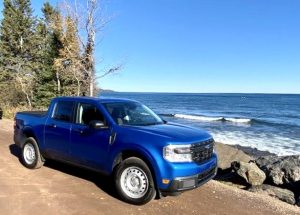
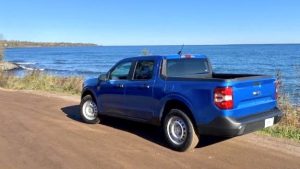
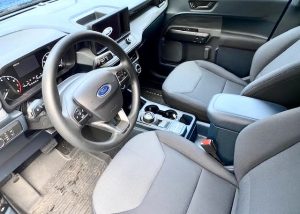
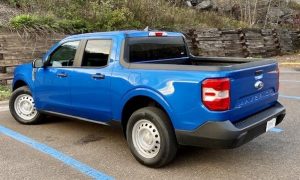
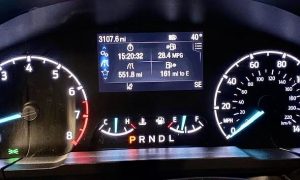
 John Gilbert is a lifetime Minnesotan and career journalist, specializing in cars and sports during and since spending 30 years at the Minneapolis Tribune, now the Star Tribune. More recently, he has continued translating the high-tech world of autos and sharing his passionate insights as a freelance writer/photographer/broadcaster. A member of the prestigious North American Car and Truck of the Year jury since 1993. John can be heard Monday-Friday from 9-11am on 610 KDAL(www.kdal610.com) on the "John Gilbert Show," and writes a column in the Duluth Reader.
John Gilbert is a lifetime Minnesotan and career journalist, specializing in cars and sports during and since spending 30 years at the Minneapolis Tribune, now the Star Tribune. More recently, he has continued translating the high-tech world of autos and sharing his passionate insights as a freelance writer/photographer/broadcaster. A member of the prestigious North American Car and Truck of the Year jury since 1993. John can be heard Monday-Friday from 9-11am on 610 KDAL(www.kdal610.com) on the "John Gilbert Show," and writes a column in the Duluth Reader.